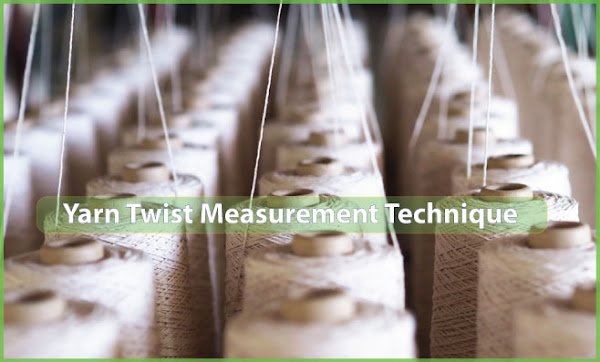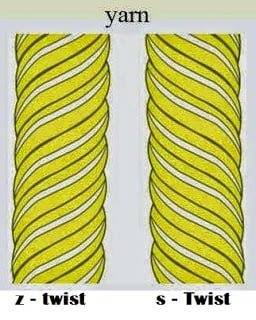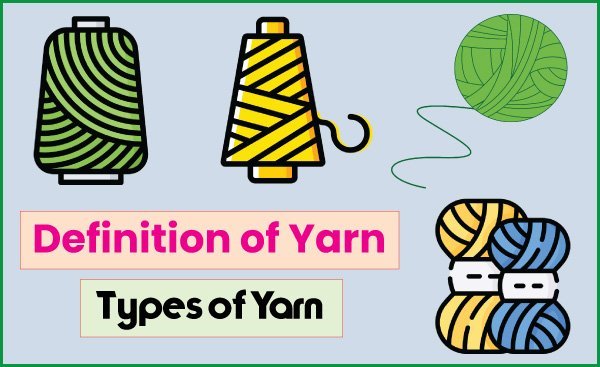Yarn Twist Measurement Techniques
Last updated on August 29th, 2023 at 11:06 am
Direct Counting Method
The essence of the method is to unwind the twist in a yarn until the fibres are parallel to the yarn axis and to count how many turns are required to do his. A suitable instrument has two jaws at a set distance apart. One of the jaws is fixed and the other is capable of being rotated. The rotating jaw has a counter attached to it to number the whole turns and fractions of a turn. Before starting any tests the samples should have been conditioned in the standard testing atmosphere.

Testing is started at least one meter from the open end of the yarn as the open end of the yarn is free to untwist so that the level of twist may be lower in that region. As the yarn is being clamped in the instrument it must be kept under a standard tension (0.5 cN/tex) as the length of the yarn will be altered by too high or too low a tension. The twist is removed by turning the rotatable clamp until it is possible to insert a needle between the individual fibres at the non-rotatable clamp end and to traverse the needle across to the rotatable clamp. The use of a magnifying lens may be required in order to test fine yarns. The twist direction and the mean turns per centimeter or per meter are reported.
Continuous Twist Tester
This apparatus is designed to reduce the amount of handling needed on consecutive twist tests and to speed up the testing process. Yarn passes through the rotating jaw end and is wound up on a rotating drum as it is moved on. Twist is assessed by the same principle as on other twist testers but after removing the twist it is put back into the yarn by rotating the counter back to zero. The rotating clamp is opened and its jaws moved forward to meet the fixed clamp; the jaws are then clamped on the yarn. The fixed clamp is opened and moving jaws are returned to the starting position, taking a new length of yarn with them; the drum takes up the slack in the yarn.
Untwist-twist Method
This method is based on the fact that yarns contract in length as the level of twist is increased. Therefore if the twist is subsequently removed, the yarn will increase in length reaching a maximum when all the twist is removed. The method uses a piece of equipment such as that shown in Fig. 4.9 in which the end of the yarn distant from the counter is attached to a pointer which is capable of magnifying its changes in length.

At the start of the test the yarn is placed under a suitable tension, either by a clip-on weight or by a weighted arm as shown. The test procedure is to untwist the yarn until all its twist has been removed and then to continue twisting the yarn in the same direction, until it returns to its original length. The basis of the method is the assumption that the amount of twist put in is equal to the twist that has been removed. However, this is not necessarily the case. For woolen yarns the method may give results up to 20% below the true value, whereas for worsted yarns the results may be 15% higher owing to fibre slippage. One source of error in the method is that at the point of total twist removal the fibres in the yarn are unsupported so that any tension in the yarn may cause the fibres to slip past one another, so increasing the length of the yarn. The difference in length if unnoticed will cause an error in the measurement of turns per unit length. Another source of error is the fact that with some yarns, when the twist is removed, the amount of twist to bring it back to the same length is not equal to the twist taken out.
Because of these problems the method is not recommended for determining the actual twist of a yarn but only for use as a production control method. There is a US standard for this method but it warns that the measured values are only an approximation of the true twist. It suggests that 16 samples are tested using a gauge length of 250 or 125 mm. However, the method is easy to use and has less operator variability than the standard method so that it is often used for measuring the twist in single yarns.
Multiple untwist-twist Method
The straightforward untwist-twist method is subject to a variable errorowing to the fact that the number of turns to return the yarn to its original length is not the same as the number of turns to take the twist out. This is mainly because when the yarn is spun some of the distortion becomes permanently set into the fibres so that when the twist is removed the yarn is not as straight as it should be. This is particularly a problem in yarns made from wool fibres, especially those that have been deliberately treated in order to set the twist.

The multiple untwist-twist method aims to overcome these problems by repeating the untwisting and twisting action which causes the error due to this source to be progressively reduced. In the test, shown diagrammatically in Fig. 4.2, the yarn is untwisted and retwisted back to its original length as in the normal test and the number of turns A noted. The value A contains an unknown error dl. Without the counter being zeroed, the direction of turning is reversed and the yarn untwisted and twisted back to its original length. This ought to bring the yarn back to its original condition, however owing to the errors the counter will show a small number of turns instead of zero. This reading is taken to be B and is due to the errors dl and d2. By untwisting and retwisting a third time a further reading C is obtained which contains the errors rfl, d2 and d3 as shown. Combining the readings A, B and C gives:
A – 2B H- C = 4x
Where, x is the number of turns in the length of yarn tested.
The method relies on the errors dl, d2 and d3 becoming progressively smaller so that the remaining error in the above equation is the difference between d2 and d3 and can be ignored. It is possible to carry out further untwisting and twisting in the same manner to reduce the error even further.
Automatic Twist Tester
An automatic twist tester is produced (Zweigle D302) which takes the tedium out of the large number of tests required for determining twist. This necessarily depends on untwist-twist type methods for determining twist levels as it cannot detect fibre straightening automatically.
Take-up Twist Tester
Take-up is the difference between the twisted and untwisted length of a yarn. Twist testers are available with a movable non-rotating jaw which is slid away from the rotating jaw to take up the slack as the twist is removed. This allows the length difference to be measured.
You may also like: Processing Flowchart of Cotton Yarn Manufacturing




My rather long internet look up has at the end of the day been compensated with pleasant insight to talk about with my family and friends.
I am continually searching online for ideas that can aid me. Thx!